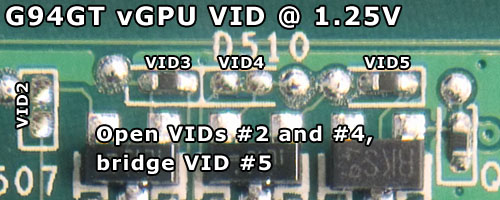GeForce 9600 GT Voltmods |
|
GPU Voltage Mod
vGPU mod for the GeForce 9600GT 512MB involves soldering on several tiny solder pads located near the edge of the circuit board. For the exact location of the solder pads in question refer to the picture in the paragraph: Overview and look for the red rectangle labeled as ”vGPU”. The idea of the modification is to reprogram the vGPU controller chip to aim at a voltage value higher than default. In a sense we're setting a new stock vGPU voltage, as unlike conventional voltage mods, this mod in no way ”deceives” the voltage controller chip. Due to this detail the mod also completely bypasses the extremely aggressive over voltage protection function typical to reference design 9600 GT.
For the record, here is what your unmodded card should look like. The pad-pairs we're going to solder on are labeled here as ”VID2”, ”VID3”, ”VID4” and ”VID5”, each pair of pads is marked with two red dots.
If you're wondering where did VID0, VID1 go – don't bother. This numbering scheme exists only for the convenience of your's truly. :)
- ”open VID” = no connection between the red dots.
- ”bridged VID” = connection between the red dots.
- ”connection” = tiny black surface mount 0Ω resistor. A blob of solder connecting the pair of pads works just as fine.

To achieve 1.15V vGPU voltage one needs to set up the VID pads as instructed above.

Same for procedure for 1.20V.

Here's 1.25V.

And so on. 1.30V.

1.35V.

1.40V.

1.45V.
When powering up the first time after altering the VID remember to check that the actual vGPU voltage is what it was supposed to be.
To measure vGPU take the red probe of your multimeter and touch any of the points marked with dots inside the blue rectangle (see paragraph: Overview), black probe into a ground (Molex connector, eg.). Default vGPU voltage for the GeForce 9600GT is 1.10 V at idle, note that vGPU increases spontaneously by ~0.05 V when entering 3D load. Preliminary reports indicate that vGPU voltages above 1.40 V yield no significant OC headroom.
Caution!
Higher vGPU voltages will cause the heat output and temperature of the GPU chip and the voltage converter circuit to increase dramatically. Make sure you provide adequate cooling on the GPU as well as the whole card when overvolted and overclocked.
Apr 17th, 2025 02:47 EDT
change timezone
Latest GPU Drivers
New Forum Posts
- Windows 11 General Discussion (5986)
- Your PC ATM (35358)
- Need advice RAM for Asus Maximus hero z890 + core ultra 7 265k (34)
- Windows 11 fresh install to do list (38)
- RX 9000 series GPU Owners Club (338)
- Advice for DDR5 CU-DIMM 2 x 24gb 8400mhz (32)
- How to relubricate a fan and/or service a troublesome/noisy fan. (241)
- EVGA 3070ti hotspot is too high 107.7° (10)
- Will you buy a RTX 5090? (479)
- 5070 Ti power limit questions (42)
Popular Reviews
- G.SKILL Trident Z5 NEO RGB DDR5-6000 32 GB CL26 Review - AMD EXPO
- ASUS GeForce RTX 5060 Ti TUF OC 16 GB Review
- ASUS GeForce RTX 5080 TUF OC Review
- NVIDIA GeForce RTX 5060 Ti PCI-Express x8 Scaling
- DAREU A950 Wing Review
- Palit GeForce RTX 5060 Ti Infinity 3 16 GB Review
- ASUS GeForce RTX 5060 Ti Prime OC 16 GB Review
- Zotac GeForce RTX 5060 Ti AMP 16 GB Review
- The Last Of Us Part 2 Performance Benchmark Review - 30 GPUs Compared
- Sapphire Radeon RX 9070 XT Pulse Review
Controversial News Posts
- NVIDIA GeForce RTX 5060 Ti 16 GB SKU Likely Launching at $499, According to Supply Chain Leak (182)
- NVIDIA Sends MSRP Numbers to Partners: GeForce RTX 5060 Ti 8 GB at $379, RTX 5060 Ti 16 GB at $429 (127)
- Nintendo Confirms That Switch 2 Joy-Cons Will Not Utilize Hall Effect Stick Technology (105)
- Over 200,000 Sold Radeon RX 9070 and RX 9070 XT GPUs? AMD Says No Number was Given (100)
- Nintendo Switch 2 Launches June 5 at $449.99 with New Hardware and Games (99)
- NVIDIA Launches GeForce RTX 5060 Series, Beginning with RTX 5060 Ti This Week (92)
- Sony Increases the PS5 Pricing in EMEA and ANZ by Around 25 Percent (85)
- NVIDIA PhysX and Flow Made Fully Open-Source (77)